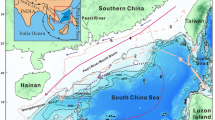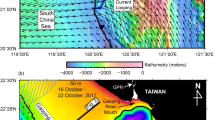Abstract
A distinct echo-character was assigned to sedimentation processes, which were then verified using data from surface sediment samples and piston cores. Of echo types on the continental slope perfectly reflecting both sediment erosion and deposition, four sedimentary types have been recognized: (1) submarine slides distributed on the shelfbreak and characterized by high silt and water content, loose structure, poor consolidation and low shearing strength; (2) slumps occurring on the shelfbreak, middle slope channel and reef margin near Dongsha Islands, but having different origins; (3) debris flow occurring either in sea areas around Dongsha Atoll, or on the continental slope's three channels, where the transparent debris flow deposits often overlie or abruptly truncate highly stratified hemipelagic sediments; are of limited to local extent, ranging from a few square kilometers to hundreds of square kilometers in area; but on the lower slope, usually occur as 1000 km2, about 100km2 individual complexes; and (4) turbidites, limited on the continental slope; some occurring as migrating waves of sediments at the toe of the slope, and are rhythmically-bedded, coarse-grained. Their migration is a result of overbank flow downslope through the submarine channel at the west. The slope faces are dominated by mass wasting deposition, and a few turbidite current sediments. Mass wasting is an important process. Some debris flow complexes on the west are buried by well-stratified conformable sediments, whereas others on the east appear on the present seafloor and therefore are relatively recent.
Similar content being viewed by others
References
Barnes, P.M., 1994. Pliocene-Pleistocene unit of the continental slope off central New Zealand: control by slope currents and global climate cycles.Marine Geology 117: 155–175.
Damuth, J.E., 1975. Echo-character of the west equatorial Atlantic floor and its relationship to dispersal and distribution of terrigenous sediment.Marine Geology 18: 17–45.
Damuth, J.E., 1979. Migrating sedimentation processes in the South China Sea Basin.Geology 7: 520–523.
Damuth, J.E., 1980. Quaternary sedimentation processes in the South China Sea Basin as revealed by echo-character mapping and piston cores studies.In: Hayes, D. E. (ed.), The tectonic and Geological Evolution of Southeast Asian Seas and Islands, Part I.Geophysical Monographs 23: 105–125.
Embley, K., Jacobi, D., 1986. Mass wasting in the western North Atlantic.In: Vogt, P.R. and Tucholke, B.E. (eds.), The western North Atlantic Region. Geol. Soc. Am., Boulder, Colorado, p. 479–490.
Feng, W.K., Xue, W., Yang, D., 1988. The Geological Environment of the Late Quaternary in the northern South China Sea. Guangdong Science and Technology Publication House, Guangzhou, 261p. (in Chinese)
Feng, Z.Q., Liu, Z.H., Ke, S.B., 1995. Characteristics and distribution of geologic hazards typed in the northern South China Sea.In: Liu S.Q. and Liang M.S. (eds.): Geological Hazards and Environmental Studies of China Offshore Areas, Qingdao Ocean University Press, p. 37–50.
Gaedicke, C., Wong, H.K., Liang, Y.B., 1992. Seismic stratigraphy and Holocene sedimentation at the northern margin of the South China Sea.In: Jin, X.L., Kudrass, H.R. and Pautot, G. (ed.), The Geology and Geophysics of the South China Sea. China Ocean Press, Beijing, p. 21–37.
Grant, J.A., Schreiber, R., 1990. Modern swath and subbottom profiling technology for research applications: the atlas by isosweep and Parasound Systems.Marine Geophysical Res. 12: 9–19.
Guo, Z.X., Yang, T.H., Qiu, D.Z., 1985. The South China Sea Warm Current in winter and a southwestward current on its right side.Tropic Oceanology 344(1): 1–9. (in Chinese)
Hampton, M.A., 1972. The role of subaqueous debris flows in generating turbidity current.Journal of Sedimentary Petrology 42: 277–292.
Jansen, E., Befring, S., Bugge, T. et al., 1987. Large submarine slides on the Norwegian continental margin: sediments, transport and timing.Marine Geology 74: 77–107.
Johnson, D.A., Damuth, J.E., 1979. Deep thermohaline flow and current-controlled sedimentation in the Amirante Passage, Southwest Indian Ocean.Marine Geology 33: 1–44
Kenyon, N.H., 1987. Mass-wasting features on the continental slope of Northwest Europe.Marine Geology 74: 57–77.
Klaus, A., Ledbetter, M.T., 1988. Deep sea sedimentary processes in the Argentine Basin revealed by high-resolution seismic records (3.5 kHz echograms).Deep Sea Research 35: 899–917.
Kolla, V., Eittreim, S., Sulliran, L., et al., 1980. Current-controlled, abyssal microtopography and sedimentation in Mozambique Basin, Southwest Indian Ocean.Marine Geology 34: 171–206.
Kuhn, G., Weber, M.E., 1993. Acoustical characterization of sediments by Parasound and 3.3 kHz systems: related sedimentary processes on the southwestern Weddell Sea continental slope, Antarctica.Marine Geology 113: 201–217.
Milliman, J.D., 1988. Correlation of 3.5 kHz acoustic penetration and deposition/erosion in the Argentina Basin: a note.Deep Sea Research 35(6): 919–927.
Mulder, T., Cochonat, P., 1996. Classification of offshore mass movements.Journal of Sedimentary Research 66(1): 43–47.
Posamentier, H.W., Erskine, R.D., 1991. Seismic expression and recongnition criteria of ancient submarine fans.In: P. Weimer and M.H. Link (eds.), Seismic Facies and Sedimentary Process of Submarine Fans and Turbidite Systems: Springer-Verlag, New York, p. 197–222.
Pratson, L.F., Laine, E.P., 1989. The relative importance of gravity induced versus current-controlled sedimentation during the Quaternary along the midest U.S. outer continental margin revealed by 3.5 kHz echo-character.Marine Geology 89: 87–126.
Rodine, J.D., Johnson, M.A., 1976. The ability of debris, heavily freighted with coarse clastic material, to flow on gentle slopes.Sedimentology 23: 213–234.
Rostek, F., Spiess, V., Bleil, U., 1991. Parasound echosounding composition of analogue and digital echo sounder records and physical properties of sediments, from the equatorial South Atlantic.Marine Geology 99: 1–18.
Salge, A., Wong, H.K., 1988. Seismic stratigraphy and Quaternary sedimentation in the Skagerrak (Northeastern North Sea).Marine Geology 81: 159–174.
Sharma, J.N., Mu, S., Soeraas, P.E., 1991. 18 months of metocean measurements in the Pearl River Mouth Basin block 29/04 in the South China Sea. Proceedings of the 23rd Annual Offshore Technology Conference,1: 391–402.
Su, G., Wang, T., 1994. Basic characteristics of modern sedimentation in the South China Sea.In: Zhou D., Liang, Y., Zeng, C. (eds.), Oceanology of China Sea, Kluwer Academic Publishers, p. 407–418.
Westbrook, G.K., Carson, B., 1992. Summary of Cascadia drilling results. Ocean Drilling Program,Proceeding, Scientific Results 146: 389–398.
Wong, H. K., Lüdmann, T., Wollschläger, M., 1994. Seismic reflection profiling at the northern continental margin of the South China Sea (Sonne−95 Cruise).In: Sarnthein, M., Pflaumann, U., Wang, P. and Wong, H.K. (eds.), Preliminary Report on Sonne−95 Monitor Monsoon to the South China Sea, Berichte-Reports,Geol.-Palaeont. Institut, Universität Kiel 68:41–53.
Wyrtki, K., 1961. Physical oceanography of the Southeast Asia waters. Scripps Institute of Oceanography, NAGA Report. 2. 195p.
Xie, Y.X., 1981. Geomorphology of the South China Sea.Nanhai Studia Marina Sinica 2: 1–12. (in Chinese)
Ye, L., 1994. On the mechanism of the South China Sea Warm Current and Kuroshio Branch in winter-preliminary results of 3-D baroclinic experiments.TAO 5(4): 597–610.
Author information
Authors and Affiliations
Rights and permissions
About this article
Cite this article
Shi-guo, W., Wong, H. & Lüdmann, T. Gravity-driven sedimentation on the northwestern continental slope in the South China Sea: Results from high-resolution seismic data and piston cores. Chin. J. Ocean. Limnol. 17, 155–169 (1999). https://doi.org/10.1007/BF02842713
Received:
Accepted:
Issue Date:
DOI: https://doi.org/10.1007/BF02842713




